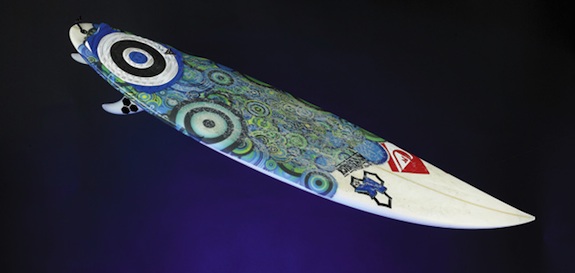Surfer Kelly Slater Searches for the Perfect Wave in New 3-D Film
Mixing science and surfing, “The Ultimate Wave Tahiti” joins the world champion in the hunt
![]()
The perfect wave. Even the most water-phobic know this is what motivates a surfer. But many may not know, there is a calculable science behind the phrase.
Experienced surfers know that the art of the sport has a lot to do with the science of the ocean. Eleven-time world champion Kelly Slater, for example, told the New York Times he checks no fewer than five different sites for reports on wind, swell and weather before he heads out. He knows that his home state of Florida has a shallow and long continental shelf, helping create small, slow waves that are perfect for beginners. He says that, “millions of years ago, lava poured out and just happened to form a perfect-shaped bottom,” producing Hawaii’s legendary Pipeline.
Now filmmaker Stephen Low joins Slater as the surfer takes on Tahiti’s most extreme surf break, Teahupo’o, in the new 3-D film, The Ultimate Wave Tahiti, debuting March 15 at the Natural History Museum’s IMAX theater. Accompanied by Tahitian waterman Raimana Van Bastolaer, Slater uses his intimate knowledge of the world’s waves to explain what makes Teahupo’o so special.
One of the most accomplished athletes in the world, Slater got his first surfboard when he was just eight. He still lives in Cocoa Beach, where he grew up going to the ocean with his parents. But Slater is more than just an athlete, he’s been actively involved in the design of his own surfboards. “Some waves are flatter in the curve of the face,” Slater told Smithsonian contributor Owen Edwards, “and provide less speed. Others are bigger, faster and hollower . You have to adjust the shape of the board accordingly. For curvier waves, a curved board works best.”

The custom-made board that carried Kelly Slater to victory in Australia in 2010 and is now part of the collections. Photo by Hugh Talman, courtesy of the American History Museum
In 2011, Slater donated the board he used at the April 2010 Rip Curl Tournament in Australia to the American History Museum. It was designed specifically for the competition site at Bells Beach by Santa Barbara company Channel Islands Surfboards. Needless to say, he won.
“No two waves are the same,” says Low. “Yet, all waves share common traits. . . to many the wave at Teahupo’o is indeed the ‘ultimate wave.’”
The film combines Slater’s years of experience and expertise with information from the National Oceanic and Atmospheric Administration to create a film that is at once educational and engaging.
/https://tf-cmsv2-smithsonianmag-media.s3.amazonaws.com/accounts/headshot/Leah-Binkovitz-240.jpg)
/https://tf-cmsv2-smithsonianmag-media.s3.amazonaws.com/accounts/headshot/Leah-Binkovitz-240.jpg)